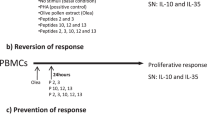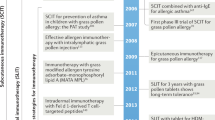Abstract
MOST of the recent work on hypersensitivity to pollens has been concerned with the isolation and characterization of the pollen allergens. The presence of biologically active materials in pollens, other than allergens, has been overlooked. The results presented here, however, demonstrate that pollen extracts contain a factor which increases vascular permeability in normal non-sensitized mice. Permeability factor was first detected by injecting Swiss Webster 20 g female mice intravenously with a mixture of 0.1 ml. of rye grass pollen extract and 0.2 ml. of 0.5 per cent Evans blue dye. Five min after the administration of dye plus pollen, a few blue spots appeared near the base of the ears; within 15 min large areas of the surface of the ears appeared deep blue. Control animals injected with dye alone showed no blueing of the ears. The most active batch of permeability factor (ED50 20 µg) has been prepared from Italian rye grass (Lolium multiflorum). The permeability factor is precipitated from an aqueous extract of this pollen by ethanol containing 6 per cant potassium chloride. The permeability factor present in alcohol-precipitable Lolium is a non-dialysable very stable material. Its permeability promoting activity is unaffected by treatment with the following agents: boiling water for 30 min; 8 M urea, 4 h; conc. ammonium hydroxide, 1/2 h; α-amylase, 37° C, 4 h; pronase, 37° C, 4 h. Lyophilized preparations of alcohol-precipitable Lolium have retained their activity for months. The data in Table 1 compare the permeability enhancing ability of alcohol-precipitable Lolium with that of known permeability factors using the ear blueing technique. It can be seen that blueing did not occur in mice injected with dye plus one of the following: bradykinin, E. coli endotoxin (Difco), Crotalus atrox venom, and trypsin. Ear-blueing occurred in mice sensitized with bovine serum albumin and afterwards challenged with bovine serum albumin, as well as in mice injected with dye plus either of the following: serotonin, histamine, or 48/80. Serotonin produced a marked blueing within seconds after its administration, while the blueing produced by histamine was faint and diffuse. After the injection of 300 µg of alcohol-precipitable Lolium the histamine content of the ears of mice dropped from 150 µg/g to 40 µg/g. Ear-blueing was inhibited by 10 µg of the antihistamine ‘Neoantergan’ or 50 µg of the antiserotonin drug ‘U M L 491’ (Sandoz). Although an antihistamine inhibits ear-blueing due to alcohol-precipitable Lolium in normal mice, it does not inhibit ear-blueing produced in bovine serum albumin-sensitized mice challenged intravenously with bovine serum albumin. It thus seems unlikely that ear-blueing from alcohol-precipitable Lolium is due to the presence of antibodies to alcohol-precipitable Lolium in the sera of normal mice. No hæmagglutinating antibodies to alcohol-precipitable Lolium have been found in the sera of normal mice, and the incubation of alcohol-precipitable Lolium with normal mouse serum prior to its injection does not result in neutralization of the ability of alcohol-precipitable Lolium to increase vascular permeability.
This is a preview of subscription content, access via your institution
Access options
Subscribe to this journal
Receive 51 print issues and online access
$199.00 per year
only $3.90 per issue
Buy this article
- Purchase on Springer Link
- Instant access to full article PDF
Prices may be subject to local taxes which are calculated during checkout
Similar content being viewed by others
References
Augustin, R., and Hayward, B. J., Immunology, 5, 424 (1962).
Sehon, A. H., and Richter, M., J. Immunol., 82, 190 (1959).
Feinberg, S. M., Feinberg, A. R., Rebhun, J., and Malkiel, S., Quart. Bull Northwest Univ. Med. School, 28, 246 (1954).
Author information
Authors and Affiliations
Rights and permissions
About this article
Cite this article
KIND, L., RICHARDS, W., SMITH, A. et al. Permeability Factor in Pollen Extracts Active in Non-sensitized Mice. Nature 203, 1390–1391 (1964). https://doi.org/10.1038/2031390b0
Issue Date:
DOI: https://doi.org/10.1038/2031390b0
This article is cited by
-
Sensitization of Mice with Human IgA
Nature (1966)
Comments
By submitting a comment you agree to abide by our Terms and Community Guidelines. If you find something abusive or that does not comply with our terms or guidelines please flag it as inappropriate.



